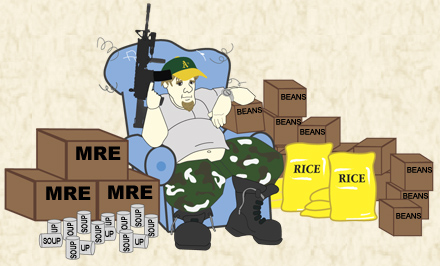Home
Chat
Room
Show Notes
Survival Enterprises
Nutritional
Products
![]()

The Armchair Survivalist
downloadable podcasts
of past radio shows
![]()
People ask me
"what do I store, where do I start?"
Here's the basics:
Food
Storage 101:
"Food For Thought,
and Your Survival"
Copyright© and Trademarked™
1984-2021 by Survival Enterprises
Catalogs & Flyers:
General Catalog - CBD Oil & Oregano - Colloidal Silver and Minerals - Ionic Minerals
|
||
|
||
|
||
|
||
|
||
|
||
|
||
|
For the latest SALE
from Survival Enterprises |
||
|
The Armchair Survivalist
FOOD FOR THOUGHT
- AND YOUR SURVIVAL Level
1 It’s simply a point of logic (and economics) to “stock up” on foodstuffs that you eat anyway. Here in North Idaho, every Wednesday and Sunday the food ads come out. Just by watching these ads, I buy bread at $ .10 to $ .25 a loaf, milk at $1.65 a gallon, beef from $ .99 per pound, canned chili around $ .15 a can, various canned fruit from $ .25 to $ .50 a can, and on and on. Being the cheap guy I am, I simply buy a case of whatever’s on sale when ever I see a good deal. My wife has this weird idea that 100 jars of peanut butter is “too much”. Go figure. So that’s the easy part of “survival food”. Just follow your local food ads and do a bit of stocking up. You can easily allocate 5% of your income to these “extra” purchases. Use common sense when stocking up and don’t waste your money on things like soft drinks and potato ships. Canned and solidly packaged items that can be shelf-stable for at least a few years should be your target. WARNING! NEVER BUY DENTED CANS TO STORE! The interior of cans is coated with a food-grade shellac, which prevents biological activity and growth. If that coating is damaged (as in a dented can) the food in the can will immediately start to react with the tin and start the formation of bacteria. Depending on the type of canned food, this could lead to YOUR DEATH! Example: as we all know, the staple diet of a teenaged boy is Mac & Cheese. Super One Food has them on sale (periodically) at 5 for a dollar. Where else can you feed someone for under a quarter? We bought two cases (48 boxes) and to protect them from nibbly critters, we took each box and put it into a zip-lock quart baggie (sandwich baggies let air through), then put all the baggied-boxes into large plastic storage tubs with lids. Tuna? Two cans for $1.00 here on sale. Perfect source of protein so get at least 24 cans per person in your household, and use that as a “rule of thumb” for your survival storage purchases. By the way: ignor any statement of BEST IF BOUGHT BY or BEST IF USED BY stamped on a can. These are 100% fraud, invented and designed to make the ignorant think that their food has gone "bad" and to make you spend more $$$. Expiration dates are also "suggestions", not science. Over the years in storage, a can will simply lose nutritional levels or taste levels. You can tell if a can is bad: it's expanded (top or bottom) or sprung a leak. I've eaten 40 year old canned beans and canned fruit I found in a miner's cabin on the Rubicon Trail! Level
2 Ok. So now you’ve got hundreds of cans of chili, beans, rice, Mac & Cheese, tuna, etc, and you figure that you might have a one year supply of food for the family (if all you eat is this canned and packaged stock). So now we plan on how to stretch this supply. Dehydrated foods are those foods that have had about 99% of moisture removed from them. Standard packing procedure is to then place an amount of food (green beans, peas, corn, soup mix, etc) in a #10 can (about a 1 gallon size), add an oxygen absorber pack, flush with nitrogen (to remove any last traces of oxygen) then vacuum seal in the can. Now you have a can of something-or-other that will have a shelf life (depending on your storage temperature) of up to 20 years. Dehydrated food generally weigh 50% to 75% less then the original version of that food. An example would be dehydrated BEEF TVP (Textured Vegetable Protein - another name for tasteless soy bean meal. Various flavorings are added to make it more palatable like beef, chicken, ham, taco and bacon flavor). You would rehydrate 1 cup of beef tvp and fry that up like normal hamburger. Cook up 1 cup of rice (which makes 2 cups of cooked rice.) Toss together with any of the seasonings you’ve stocked up on (which is as important as food - seasonings can make the most vile food taste like sirloin steak!), and you now have enough for 4 to 5 meals. By adding dehydrated food to your stocked “normal” food stuff, you now have two to four times the amount of food available. The pros about using and storing dehydrated foods are: 1) Longer storage life than “normal” canned food stuffs. 2) Dehydrated foods weigh 50% to 75% less then their original weight. 3) As dehydrated foods are used as “ingredients” (not complete meals) you can be more creative in preparation. Example: (and obviously after it’s been properly rehydrated) Beef TVP can be fried with seasonings and used in a burrito, cooked in spaghetti sauce - use it anywhere you’d normally use hamburger. The same with the other flavor TVP’s. In fact, we use the Bacon TVP on salads, potatoes and eggs. You probably do to, except you might know it as “Bacon Bits”! The cons about using dehydrated foods: 1) You must have a source of clean water to rehydrate the food. 2) All you’re gaining is longer term storage capability - it still takes time to cook. 3) Depending on where you buy, they could be more expensive then their fresh counterparts. 4) As the concept here is “storage”, you’ll need lots of space to stack these cans Canned dehydrated food is in use daily by most restaurants for soups, sauces and seasoning. Dehydrated foods are hundreds of times more “shelf stable” then their fresh counterparts, and still have up to 95% of the same nutrition still intact. NOTE: Though dehydrated food will last years in it’s original, sealed can, once it’s opened, you’ll need to use it up within a few weeks (if it’s left in it’s covered can on a shelf) or you could refrigerate the can and it’ll be safe for many months. Level
3 For long term storage (I mean 20 to 50 years), the only company to use will be Mountain House. The company is owned and operated by the original creators of the long term, freeze dried food concept. Other companies (such as AlpineAire) offer fine tasting, light weight freeze dried meals, but only Mountain House products have any long term storage capability (depending on your storage temprature, up to 50 years). Freeze dried foods have 100% of their moisture removed. Then they’re packed either in a can (usually the standard #10 size) or in light weight, easily carried foil pack (after having the oxygen flushed out with nitrogen and adding an oxygen absorber). Mountain House #10 canned foods have a 30 to 50 year shelf life. Their foil packs have a 20 to 30 year shelf life. All other freeze dried companies have around 1 to 2 year shelf life on their foil packs and cans. Most freeze dried foods are what’s called “complete entree” style. Examples are Chicken & Rice, Beef Stew, Mexican Style Chicken, etc. All you do is put your desired helping in a pot, add the appropriate amount of hot water (that’s how, stir and cover for about 15 minutes, then eat. Everything is included in these products: meat, sauce, rice, seasonings, etc. These style of meals are quick and simple to make. Be careful when buying long-term storage foods. Many fraudulant companies have sprung up in the past few years, all claiming their food "is gourmet, will store for 25 years". Tastes like cardboard, goes bad within 5 years and over priced. Until you become educated enough to actually know the difference and the truth aboyt prepackaged foods, stay with the top-of-the-line: Mountain House The pros about using and storing
freeze dried foods: 2) Extraordinary long term shelf life (depending on storage temperature) 3) Less than ½ hour to finished meal. The cons about using freeze dried foods: 1) Cost. They are very expensive, but you have to consider that you’re not buying a “meal” - you’re buying food security that can last you and your family for up to 50 years. 2) You must have a source of clean water to rehydrate the food. 4) As the concept here is “storage”, you’ll need lots of space to stack these cans Level
4 So now, the “wolf’s at the door” and danger is eminent. You want to grab something and just get outta Dodge. For quick and easy, you can always rely on MRE’s (Meals Ready to Eat). You can find either the original, higher calorie content, USGI versions, or the waaay overpriced civilian versions (check Ebay). MRE’s are compact, quick and tasty. Unfortunately, they have a storage life of around 5 to 10 years (less if stored above 65 degrees), are very expensive ($5.00 to $7.00 per meal pack) and are hard to find in bulk. So now you get a general idea of the where’s and whyfores of food storage. Just remember to "cycle" any food stores you have. Use the oldest stuff first and replace with fresh, newer stuff. In an emergency, life-or-death situation, you don't want to open a can of anything that could be dangerous.
WAYS TO LISTEN
Any suggestions or comments or
if you know of
Email Kurt at:
| ||||||||||||||||||







